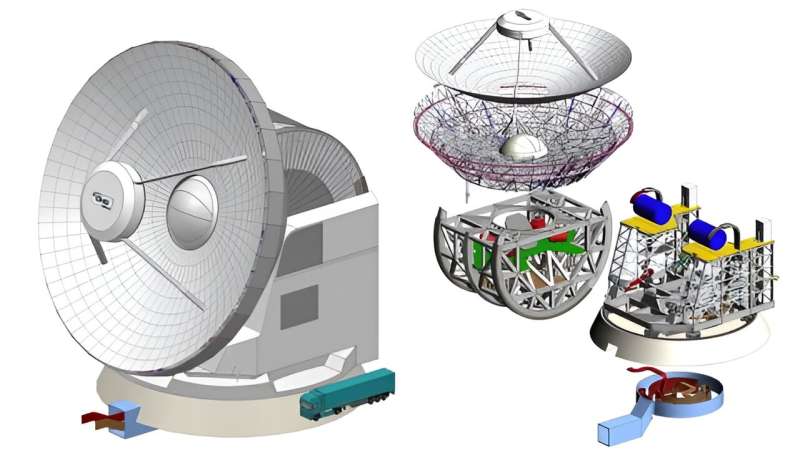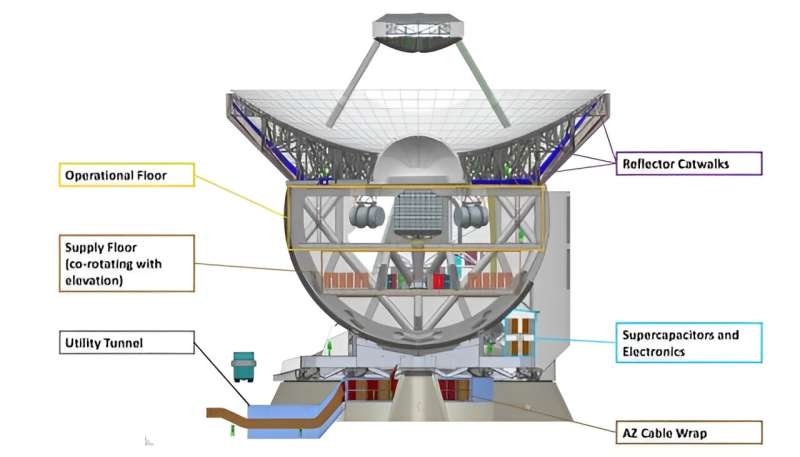This article has been reviewed according to Science X's editorial process and policies. Editors have highlighted the following attributes while ensuring the content's credibility:
fact-checked
trusted source
proofread
Astronomers propose a 50-meter submillimeter telescope

Some parts of the universe only reveal important details when observed in radio waves. That explains why we have ALMA, the Atacama Large Millimeter–submillimeter Array, a collection of 7-meter and 12-meter radio telescopes that work together as an interferometer. But, ALMA-type arrays have their limitations, and astronomers know what they need to overcome those limitations.
They need a radio telescope that's just one single, massive dish.
Many astronomical objects emit radio waves. From massive galaxies to individual molecules, radio waves and the observatories that sense them provide insights into these objects in ways that other observatories can't. But there's a problem. In order to do radio astronomy with a usable signal-to-noise ratio, astronomers need huge antennae or dishes. That's why ALMA exists. It's a collection of dishes working together via interferometry to create a much larger dish.
But as powerful as ALMA is, and as much as it continues to make a huge contribution to astronomy, it has its limitations.
That's why some in the astronomical community are calling for a new radiotelescope with one single large dish. It's called AtLAST, for the Atacama Large Aperture Submillimeter Telescope, and the idea has been fermenting for a few years. Now, a new paper is fine-tuning the idea.
The paper is titled "Design of the 50-meter Atacama Large Aperture Submm Telescope," and it's currently available on the preprint server arXiv. The lead author is Tony Mroczkowski, an astronomer and submillimeter instrument specialist at the European Southern Observatory (ESO), one of the organizations behind ALMA.
"Submillimeter and millimeter wavelengths can reveal a vast range of objects and phenomena that are either too cold, too distant, or too hot and energetic to be measured at visible wavelengths," the paper states. They point out that the astronomical community has "highlighted the need for a large, high-throughput sub-mm single dish" radio observatory that can advance radio astronomy.
"The Atacama Large Aperture Submillimeter Telescope (AtLAST), with its 50-m aperture and 2o maximal field of view, aims to be such a facility," they explain.
Their paper presents the full design concept for AtLAST.
AtLAST's large 50-meter aperture is its critical feature. Smaller apertures, even when combined together in an interferometer like ALMA, can only see more extreme features due to noise. That's why two or more smaller dishes can't replace a single large one.
There are some large-aperture radio antennae, like the Japanese Nobeyama 45 m telescope and the IRAM 30 m telescope. But due to their designs, they can't observe as well as AtLAST will. AtLAST will be able to see closer to the spectral energy distribution (SED) peak of galaxies and will be able to observe far infrared (FIR) emission lines in the interstellar medium and in high-redshift galaxies. ALMA can observe these SEDs and FIRs, but not as well as AtLAST will.
Existing large dishes also have smaller fields of view (FOV.) But AtLAST's design was driven by the need for a larger FOV of 2 degrees. This will give AtLAST a much higher mapping speed for science cases that need large fields of several hundred degrees square.
AtLAST's overarching scientific goal is multifaceted. The telescope will perform the most complete, deepest, and highest-resolution survey of the Milky Way. This includes gas clouds, protoplanetary disks, protostars, and dust. AtLAST will even survey some parts of the Local Group of Galaxies. The radio telescope will even be able to detect complex organic molecules, the precursors to life.
The gas and dust in the universe are of particular interest to AtLAST. Much of the gas and dust in the universe is cold and dense. The interstellar medium (ISM) consists of clouds of gas and dust that have unique spectral signatures in the sub-millimeter range. ALMA has given us some of our best looks at these structures with high-resolution images of some of the fine details of the ISM. But single-dish antennae have given astronomers glimpses of other discoveries waiting to be made. That's one of the reasons the international astronomy community is so enthusiastic about AtLAST.
AtLAST will also be able to take a census of star-forming galaxies at high redshifts. It'll also map out the reionization of the universe and track the universe's dust, gas, and metallicity across cosmic time.
AtLAST will dig into the deeper, fundamental aspects of galaxies by examining the circumgalactic medium (CGM). The CGM is cold gas and dust that exists in galactic haloes and shapes the evolution of galaxies. This material is invisible at other wavelengths.
The radio telescope's single-dish design has some advantages over ALMA that are separate from its dish size and its field of view. As a single-dish antenna, AtLAST will be able to switch targets quickly and even track moving targets. It'll employ several different scanning modes, as well as tracking modes that allow the telescope to track comets, asteroids, and near-Earth objects. Its innovative rocking chair design is behind some of AtLAST's performance, a design it shares with extremely large optical telescopes like the ELT.

AtLAST will be designed to last many decades. It'll have six instrument bays and will allow rapid switching between instruments. With a nod to our changing climate, AtLAST will be powered by renewable energy.
But what it's really all about is science.
"The design presented here is expected to meet all of the specifications set for AtLAST to achieve its broad scientific goals," the paper states. The details of the design allow it to meet the stringent requirements needed to reach its goals. "Namely, these are the large field of view, the high surface
accuracy, fast scanning and acceleration, and the need to deliver a sustainable, upgradeable facility that will serve a new generation of astronomers and remain relevant for the next several decades."
It's a complex project, as are all astronomical observatories. But as technology advances, so does the complexity. There's a lot of work yet to be done and quite a bit of time before construction can even begin.
"Despite the amount of work that remains to be done, AtLAST is on track to potentially begin construction, if fully funded, later this decade," the authors conclude.
More information: Tony Mroczkowski et al, Design of the 50-meter Atacama Large Aperture Submm Telescope, arXiv (2024). DOI: 10.48550/arxiv.2402.18645
Provided by Universe Today




















